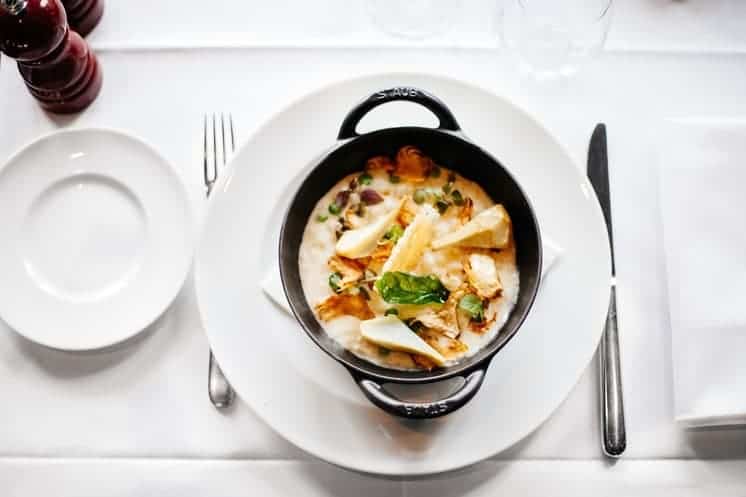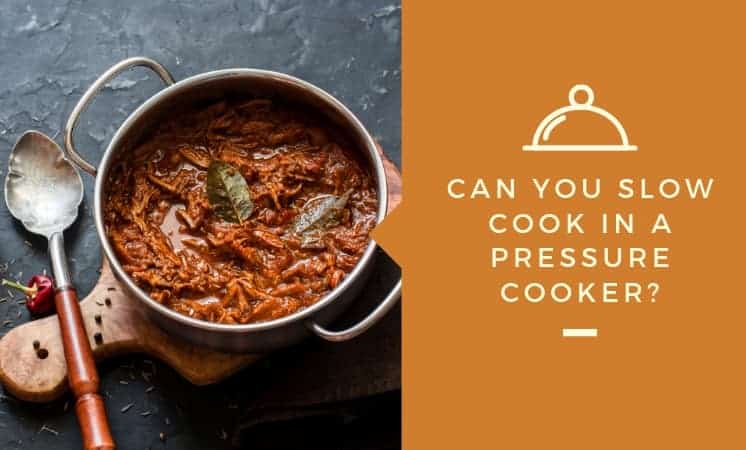Many electric pressure cookers, such as the Instant Pot, come with the ability to do so much more than just pressure cooking. Trust me, I know, it sounds appealing to have a bunch of different methods of cooking available at the push of a button.
Some functions are easier to master than others, but that’s no reason to avoid using them. With that in mind, I decided to write a little guide on slow cooking in a pressure cooker to simplify the process for those who come looking for what I once looked for.
Can you slow cook in a pressure cooker?
Any electric pressure cooker with a slow cooking function can be used to slow cook. Pressure cooking is faster than most other methods of cooking, so recipes that were originally made for the slow cooker must be converted to fit the pressure cooker.
The Instant Pot, a multi-cooker capable of pressure cooking and slow cooking, must also be tweaked to slow cook successfully.
Slow cooking in a pressure cooker is nothing like slow cooking in a slow cooker – there’s a slight learning curve to the process. It may seem like a daunting task at first but when you’re done reading this article, you’ll know your way around it.
Take the Instant Pot for example, it has a button that says “Slow Cooker” but pressing that button doesn’t magically transform your Instant Pot into a pressure cooker – there’s more work needed to achieve the best results.
Once in Slow Cooker mode, the temperature of the Instant Pot can be changed. The user is given the possibility to choose between three different heat settings.
- Low/less on an Instant Pot translates to keep warm on a slow cooker.
- Medium/normal on an Instant Pot is like low on a slow cooker.
- High/more on an Instant Pot is medium-high on a slow cooker.
These Instant Pot settings operate at
- Less: 180˚F to 190˚F
- Normal: 190˚F to 200˚F
- More: 200˚F to 210˚F
Now that you’ve configured the Instant Pot and are ready start cooking, you’ll notice that the Instant Pot’s lid is made of stainless steel and is sealed shut, which makes it very hard to check on the food while you’re slow cooking it.
This design isn’t unique to the Instant Pot, in fact, almost all pressure cookers look like that. It’s a huge disadvantage when slow cooking. The pressure cookers ability to keep steam from escaping is great when pressure cooking but we don’t want to trap the moisture inside the cooker when we’re slow cooking.
The company that manufactures the Instant Pot has come up with a solution to the problem – a replacement lid made of glass. The lid can be ordered from their website.
How Do You Use a Pressure Cooker as a Slow Cooker?
While electric pressure cookers aren’t as good as slow cookers in this regard, they can still be used to cook delicious meals.
- Take pressure into account
- Add liquid
- Adjust time
- Adjust temperature
To produce steam, a pressure cooker requires at least 1 cup of water but may need more in many cases. Without any liquid, the pressure inside the vessel won’t increase – rendering the appliance useless. Broth, water, beer, stock, and wine are all excellent choices for the pressure cooker.
The same isn’t true for slow cookers where the liquid is produced from condensation created during the cooking process.
Electric pressure cookers with a slow cooking function oftentimes come with 3 heat settings, just like most slow cookers. These heat levels don’t correspond with one another.
Electric pressure cookers like the Instant Pot don’t reach temperatures as high as the slow cooker, recipes that are originally made for the slow cooker must, therefore, be adjusted – otherwise, the user will most likely open up the pressure cooker only to find an uncooked meal.
- When a recipe calls for the “low” setting: Cook it on”normal” or “low” but add about an hour on the clock if you’re cooking on low.
- If a recipe calls for the “high” setting: Use “more” when a recipe calls for “high” and add 15 minutes for each hour (these terms are Instant Pot terms – but any equivalent on your pressure cooker works)
Take the build-up of pressure into account when cooking in the pressure cooker. The steam pressure inside the cooker doesn’t magically appear, it takes time to produce it. The time it takes for the pressure cooker to reach pressure depends on the following:
- The temperature of the liquid added to the cooker
- The amount of liquid
- The temperature of the ingredients added
- The power of the heating element
In general, it takes somewhere between 5-30 minutes for a pressure cooker to reach pressure. When the pressure cooker has completed the cooking cycle, the appliance has to depressurize before the user can open the lid. This takes anywhere between 5-15 minutes, depending on which method of releasing pressure is used.
Important: Make sure that the vent is switched to “sealing” and not “venting” or you’ll have a hard time building pressure in the cooker.
How To Convert Slow Cooker Recipes Into Pressure Cooker Recipes
An electric pressure cooker such as the Instant Pot is made to cook food faster – this goes against the methods of the slow cooker and recipes must be converted to pressure cooker-friendly versions.
This is how I go about converting my recipes.
- Add liquid: I mentioned that pressure cookers require liquid in order to produce steam – a minimum of 1 cup of liquid should be added to the cooker to avoid burning the container’s contents.
- Cut back on the ingredients: Slow cookers can be filled to the top with ingredients – pressure cookers don’t handle the same kind of volume as well. An overfilled pressure cooker won’t pressurize, and without pressure, the cooker won’t work properly. Scaling down on the recipe solves this.
- Adjust time: Slow cooking in a slow cooker is a time-consuming endeavor that can last for 8-10 hours. In the pressure cooker, a meal can be completed in 30 minutes plus the time it takes the appliance to build pressure. Use cheat sheets until you get the hang of it.
- For best results, add ingredients on the go: Some ingredients shouldn’t be cooked as long as others and will taste much better if they are added later in the process. Opening up the pressure cooker releases the pressure but it can quite easily build up again since the ingredients are already hot.
The process can be sped up further by
- Adding warm water: The warmer the water, the quicker the Instant Pot/PC will come to a boil.
- Defrosting ingredients: Frozen ingredients will lower the temperature inside the pressure cooker – adding an extra 5-10 minutes.
What’s the Difference Between a Pressure Cooker and a Slow Cooker?

Both the pressure cooker and slow cooker are amazing appliances that offer simple solutions to our everyday lives. If you were looking at the end result of these two, you would probably have a hard time pointing out which meal came out of which appliance. But even though they produce similar results, they are still different in many ways.
Slow cookers have a gentle approach to cooking – which takes anywhere from 4 to 10 hours but, thankfully, the appliance can be left unattended once it starts cooking – they can even be used to cook overnight or during the day when you’re out of the house.
They produce tender, juicy results that fall right off the bone. The same results can be achieved in a pressure cooker in 30 minutes or less – thanks to the increased pressure inside the vessel. The steam that builds up pressure also keeps the food moist and tender.
Slow cooking may not save as much time as pressure cooking does but it is slightly easier to get right the first times around. Slow cooking doesn’t revolve around steam pressure, the appliance can, therefore, be opened halfway through to check on food or add more ingredients.
Of course, the pressure cooker can also be opened up and adjusted halfway through but as the pressure escapes when the lid is opened, the cooker must build up pressure again – a procedure that takes less time once the pressure cooker is hot.
Both are great when cooking beans, grains, meat, poultry, stews, vegetables, and more. While both come with pros and cons, I believe that an electric pressure cooker like the Instant Pot is a very valuable asset in any kitchen because of the functions it provides and the speed it is capable of delivering them in.
Is It Better To Slow Cook or Pressure Cook?
The primary difference between a slow cooker and a pressure cooker is speed. The pressure cooker is much quicker than the slow cooker but they’re capable of producing similar results.
Both are great for cheaper cuts of meat, both are great for chicken, both are great for stews. I think there’s so much that makes both of these great.
The slow cooker is famous for making meat incredibly tender. After a 4-hour cycle in the slow cooker, most cuts of meat will fall into pieces by merely touching them. You can achieve the same tenderness in the pressure cooker in a shorter amount of time.
This makes the pressure cooker the better choice for someone who doesn’t like to plan ahead.
Seeing as the pressure cooker can cook a meal in just a fraction of the time that it would take the slow cooker, the pressure cooker is the best choice for those who like to go with the flow rather than plan and prepare.
The pressure cooker is also a better choice for those who cook a lot of beans and vegetables. Cooking greens in the slow cooker makes them quite mushy as they spend so much time in the slow cooker. The pressure cooker preserves the texture of the vegetables instead of making them mushy.
If you’re keen on canning food, then the pressure cooker might be the better choice as some pressure cooker some with a pressure canning option.
The slow cooker is also a great appliance and I use it on a weekly basis. I’m on a strict diet that’s very structured so I know what I’m going to eat every day and how much of each ingredient. This makes it extremely easy for me to prepare meals for the slow cooker and just leave it be while I’m at work.
It’s also supposed to be better at retaining nutrients and vitamins than other methods of cooking that expose food to high heat for an extended period of time.

